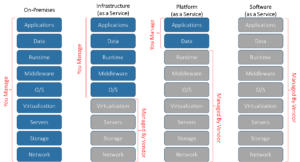by Mark Sontz –
More and more organizations are moving to the cloud to enable innovation, cost savings, scalability, IT transformation, and ease of management. cloud platforms such as Amazon Web Services (AWS), Microsoft Azure and Google Cloud enable complex business models to achieve their goals with more ease than ever before while also allowing for faster technology development and the creation of competitive advantages.
The benefit of the cloud is one where the organization is both more efficient while achieving their business growth goals. Business growth is defined differently by many organizations. For some, it may mean increasing profitability and sales volume. For others, it’s a faster time to market and better customer experience. No matter the measurement, the speed at which an organization needs innovation is increasing. Cloud adoption has taken effect as even traditionally non-technical organizations are finding themselves using more technology than ever.
By 2020, at least a third of all data1 will pass through the cloud
In most organizations, cloud adoption is a company-wide event with a top-down, approach. Executives at the top of an organization are driving to meet business requirements down to their IT teams who then execute on a plan.
With change comes great responsibility. The key question is, how do you keep this new environment running as efficiently as possible? The cloud has great benefits, but without proper management, organizational goals cannot be achieved. The role of IT has shifted. It’s less management of physical systems and more responsibility to monitor systems – ensuring uptime, and meeting Service Level Agreements (SLA’s). In addition, executive management is constantly faced with new pressures such as regulatory compliance challenges which include everything from data privacy and security to customer satisfaction. The entire organization relies on IT’s ability to maintain everything in the cloud environment.
Once operational, the need for visibility becomes critical. Executives want to see the results of this transformation to the cloud.
- Is it meeting the business objectives?
- Are there cost savings and efficiencies?
- Is everything running as it should without issues?
Why Organizations are Migrating Systems to the Cloud
Some companies, such as e-commerce businesses, are built from the ground up on the cloud, while others have a more traditional operating model, but all can benefit from using the cloud in their operations. Some of the primary reasons include:
Achieve Business Growth
Business growth is one of the top benefits organizations have realized as a result of cloud adoption. Cloud gives you the power to expand infrastructure quickly, test innovations faster, and accelerate technology driven go-to-market plans and potentially accelerate business growth.
Increase Efficiency
Efficiency is a top area that organizations strive to improve by going to the cloud. At its core, efficiency is about removing unnecessary steps to streamline processes in order to increase productivity or deliver on customer requirements faster. As a result, increasing efficiency also supports business growth.
Improve Customer and User Experience
Organizations are looking to the cloud to improve the quality of the customer experience. Customers expect and demand that the applications they use are always up and available no matter where the user is trying to access them from. Cloud adoption delivers on this promise while also allowing new channels of engagement and improved workplace productivity which all adds up to more satisfied, repeat customers who will promote your service to others.
IT Agility
Cloud technologies improve IT agility and enable IT to be more responsive to business needs and react faster to market changes. It makes responding to down services and alerting customers faster, easier, and cheaper, which leads to happy and engaged users. The user is no longer in the dark, and IT is no longer consumed with traditional application and hardware management tasks. In addition, cloud technologies are easy to enhance and adapt to accommodate changing business needs.
Faster Development and QA
For organizations with developers, the cloud offers on-demand test and development environments which streamlines the development cycle into a more agile environment where changes happen faster.
Cost Management
The cost driver has two sides: reducing IT expenses and restructuring these expenses to spread them out over time. Expenses shift from upfront capital expenses to monthly operating expenses.
Assurance and Reliability
Assurance is the idea that data is more secure in the cloud and that organizations will attain better uptime because its solutions are maintained by the cloud provider, which has built its business around these competencies and has proven to be successful.
Cloud Service Models
There are three service models depending on how far you want to invest in the cloud:
- Infrastructure as a Service
- Ready to rent
- Network, Compute, Storage
- Platform as a Service
- Ready to use
- Tools and services to create and deploy applications
- Software as a Service
- Ready to wear
- Use provider’s application over a network
The following diagram depicts the separation of responsibilities and delineates between what is managed by the cloud provider and what is managed by the client.

Steps to Cloud Migration
Embracing the cloud may be a cost-effective business solution, but moving data from one platform to another can be an intimidating step for technology leaders.
In fact, ensuring smooth integration between the cloud and traditional infrastructure is one of the top challenges. Together with security concerns, these are the significant issues CIOs face when considering cloud adoption and strategies.
Server migrations do involve a certain degree of risk. Downtime and data loss are two critical scenarios to be aware of before starting the process.
1. Plan your Migration
Organizations must have a clear strategy, map out a realistic project timeline, and limit the number of variables and dependencies for transitioning on-premises applications to the cloud.
- Assess your current cloud operational maturity including people, process, and technology
- Validate business cases for applications and services that can provide financial and operational benefits from migrating to the cloud
- Develop a roadmap for getting to your desired state including procurement strategies, capacity planning, vendor management, and cloud operating models
2. Inventory your Assets
- Build a holistic view of your data center assets, IT portfolio, and their relationship to specific cloud assets and services
- Take inventory of your assets before deciding what to migrate to the cloud
- Define dependencies to ensure that nothing breaks during or after a migration
- Visualize assets and dependencies in a single view, whether on-premise or in existing public or private clouds
3. Forecast Your Cloud Costs and Calculate Your ROI
Cloud migration is not inexpensive. You need to pay for the cloud infrastructure and the engineering involved in moving and storing your data and applications.
However, although this appears to be one of the many migration challenges, it is not. As cloud has become popular, its costs are falling. The Return on Investment or ROI, for cloud infrastructure and services also makes the price worthwhile.
- Understand the cost of migrating to the cloud before you make the move
- Simulate migrations to cloud services and deploy the right resources at the right cost
- Align cloud expenses with business needs and resource costs
- Leverage the move to find efficiencies and reduce costs
- Review your workflows (systems and people) to determine what resources may be eliminated or re-purposed
4. Ensure Compliance and Security
Before you begin the cloud migration process, you need to be aware of the related security and regulatory requirements. There are numerous regulations that you must follow when moving to the cloud. These are particularly important if your business is in healthcare or financial services. In this case, one of the challenges is working with your provider on ensuring your architecture complies with government regulations.
- Not only does the data in the cloud need to be stored securely, but the application migration strategy should keep it safe as well.
- Find and fix security risks and compliance gaps
- Verify security and policy-based compliance across cloud production environments
- Enhance visibility of security and compliance posture within your monitoring platform
Cloud Migration
So how do you transition to the cloud?
What Good Looks Like
Migration is a complicated process, but it’s not a dark art, and overcoming some of the most common (and most severe) pain points is often just a case of having prepared sufficiently.
Below are 7 strategies and categories for assessing and migrating your data and applications.

Conclusion
Migration doesn’t just happen overnight – not without planning at least. In fact, Bloor Research’s ‘Data Migration in the Global 2000’ survey found that in migration projects, insufficient scope definition caused:
- Over 50% of respondents to run over budget
- Over 66% of respondents to run past the planned duration
A failure to plan sufficiently isn’t necessarily indicative of technical difficulty. Quite the opposite in fact: the biggest migration challenges are usually a question of perception.
Many customers are surprised when the migration process is painless; there’s frequently an expectation that it will be disruptive and costly and take too long.
Ultimately though, the best piece of migration advice for anyone who owns a digital environment is to not let the need arise unexpectedly. Position it as an expected event under the total cost of ownership. You’ll sidestep the financial and operational shock of discovering it as an urgent need and encourage better day-to-day data management policies.
Organizations are getting smarter about migration, and many are now choosing to work with experienced partners after recognizing it as the self-contained process it is. Doing so almost always makes the movement of data, applications, and infrastructure a non-disruptive process.
Works Cited
1. https://www.baselinemag.com/

